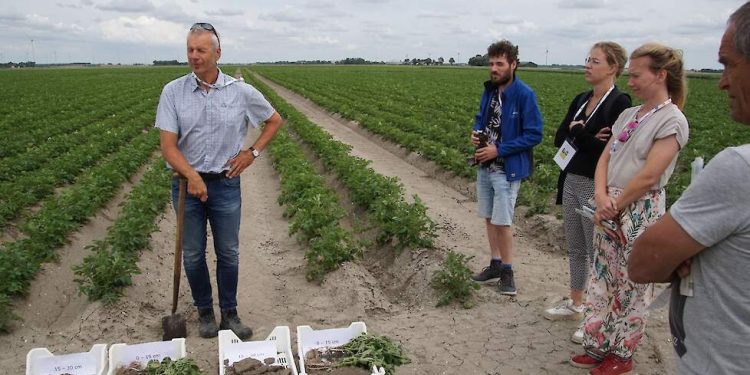Soil compaction occurs on all soils in the Netherlands. Growers know what the causes are, but do not always act accordingly. According to researcher Derk van Balen of WUR Open Teelten, this is because there are obstacles to changing behavior: there are agreements with buyers or a lack of personnel forces companies to use (too) heavy machines on the land under less ideal conditions.

Van Balen explained soil compaction at a workshop on this subject for Groen Kennisnet. In it he first showed on what grounds compaction occurs. In fact, this applies to all soils, sand or clay. An overview map of the Netherlands shows that tens of percent of the soil in important arable areas has compacted soil on the clay. Van Balen says that eliminating the compaction in the deeper layers and the plow sole is particularly difficult. The top layer of the soil is cultivated annually and is therefore kept looser.
Prontosaurus
The researcher compared the development of agricultural machinery with the animal kingdom. “Large animals have a larger footprint to avoid sinking into the ground. The largest land animal that ever lived on Earth, the Prontosaurus, weighed up to 60 tons. To prevent it from sinking into the ground, this animal had very large footprints. Our current mechanization is starting to look like that prontosaurus.”
Yet the solution for compaction in machines is not simply to reduce axle loads and increase the contact surface of the tires. According to Van Balen, this contributes to less smearing and ruts, but such heavy machines still compact the soil at greater depths, especially under wet conditions.
If growers know what causes compaction and they know it can mean more than 20 percent yield loss, why don’t they do more to prevent it? According to the researcher, this is due to factors over which they do not have sufficient control. “Agreements in the chain is one such reason. The customer, a factory or a supermarket, has a plan. The grower will still harvest under poor conditions.”
Another cause of densification is the increase in scale. “Not enough staff,” says Van Balen. As a result, a handful of arable farmers, contractors and staff have to work with machines that have a large capacity. With the increase in scale and specialization, land exchange and leasing of land is another factor. Investing in temporary land is too expensive for entrepreneurs who will grow elsewhere next season.
Blur
“Swedish research shows that there is a dormant average loss of 3 to 4 percent due to compaction of the subsoil. It is partly obscured by irrigation and other cultivation measures.” If the soil can supply less moisture and nutrition due to a compacted layer upwards, farmers can solve this in a moment, but that also comes at a cost.
While there are rules on the road for maximum axle loads for agricultural machines, this does not apply on land. Guidelines for this could contribute to soil quality. “There are examples of lighter machines. Consider trailed sugar beet harvesters with a limited bunker capacity. It must fit your business operations. Those bunkers are too small if you have very long plots. There are also harvesting machines that work from fixed tramlines. Tires and tracks always travel over the same path. You still have compaction there, but only on the trails. The beds are unused.”
Another solution is to work with lighter robots, possibly in groups. “Robots are not yet completely autonomous. We have to get rid of those machines that are much too heavy. There are technical solutions, but we still have some hurdles to overcome.”
Dates
It requires a chain approach to reverse the compaction of soils, Van Balen thinks. For industrial vegetables, sugar beets and other agricultural products, growers can look for solutions for compaction in consultation with supermarkets, factories or landowners. “We are working on a start on this within the Green Chains project.”
Where growers prevent compaction, Van Balen sees recovery of the soils. “Soil can recover naturally, for example during dry summers on clay soils. Green manures and more grains in the crop plan are positive and growers can better choose harvest times. In the long run, you need less power on the looser soils that arise and you can work that soil with lighter machines.”
Preventing compaction
According to Van Balen, preventing compaction is the best measure. The knowledge from the research is therefore already used in agricultural training and by advisors and growers. Increased yields and fuel savings are advantages. Water puddles and poor soil penetration are indicators of compaction. Arable farmers who consciously look at this and adjust soil management to prevent and restore this improve their soil. Axle loads of less than 10 tons and tire pressure of less than 0.8 bar reduce risks. According to Van Balen, the resilience of the soil can withstand some, but it is very important ‘not to push that limit’. Then the compaction will not easily recover by itself.



